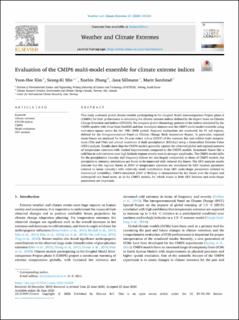| dc.contributor.author | Kim, Yeon-Hee | |
| dc.contributor.author | Min, Seung-Ki | |
| dc.contributor.author | Zhang, Xuebin | |
| dc.contributor.author | Sillmann, Jana | |
| dc.contributor.author | Sandstad, Marit | |
| dc.date.accessioned | 2021-08-13T10:24:36Z | |
| dc.date.available | 2021-08-13T10:24:36Z | |
| dc.date.created | 2020-07-21T09:39:47Z | |
| dc.date.issued | 2020 | |
| dc.identifier.citation | Weather and Climate Extremes. 2020, 29 . | en_US |
| dc.identifier.issn | 2212-0947 | |
| dc.identifier.uri | https://hdl.handle.net/11250/2767750 | |
| dc.description.abstract | This study evaluates global climate models participating in the Coupled Model Intercomparison Project phase 6 (CMIP6) for their performance in simulating the climate extreme indices defined by the Expert Team on Climate Change Detection and Indices (ETCCDI). We compare global climatology patterns of the indices simulated by the CMIP6 models with those from HadEX3 and four reanalysis datasets and the CMIP5 multi-model ensemble using root-mean-square errors for the 1981–2000 period. Regional evaluations are conducted for 41 sub-regions, defined for the Intergovernmental Panel on Climate Change Sixth Assessment Report. In particular, regional mean biases are analyzed for the 20-year return values (20RV) of the warmest day and coldest night temperatures (TXx and TNn) and annual maximum of daily precipitation (RX1day) using a Generalized Extreme Value (GEV) analysis. Results show that the CMIP6 models generally capture the observed global and regional patterns of temperature extremes with limited improvements compared to the CMIP5 models. Systematic biases like a cold bias in cold extremes over high-latitude regions remain even in stronger amplitudes. The CMIP6 model skills for the precipitation intensity and frequency indices are also largely comparable to those of CMIP5 models, but precipitation intensity simulations are found to be improved with reduced dry biases. The GEV analysis results indicate that the regional biases in 20RV of temperature extremes are dominated by GEV location parameter (related to mean intensity) with relatively small contribution from GEV scale/shape parameters (related to interannual variability). CMIP6-simulated 20RV of RX1day is characterized by dry biases over the tropics and subtropical rain band areas, as in the CMIP5 models, for which biases in both GEV location and scale/shape parameters are important. | en_US |
| dc.language.iso | eng | en_US |
| dc.publisher | Elsevier | en_US |
| dc.rights | Navngivelse 4.0 Internasjonal | * |
| dc.rights.uri | http://creativecommons.org/licenses/by/4.0/deed.no | * |
| dc.subject | Climate extremes | en_US |
| dc.subject | ETCCDI indices | en_US |
| dc.subject | CMIP6 | en_US |
| dc.subject | Model evaluation | en_US |
| dc.subject | GEV analysis | en_US |
| dc.title | Evaluation of the CMIP6 multi-model ensemble for climate extreme indices | en_US |
| dc.type | Journal article | en_US |
| dc.type | Peer reviewed | en_US |
| dc.description.version | publishedVersion | en_US |
| dc.source.pagenumber | 0 | en_US |
| dc.source.volume | 29 | en_US |
| dc.source.journal | Weather and Climate Extremes | en_US |
| dc.identifier.doi | 10.1016/j.wace.2020.100269 | |
| dc.identifier.cristin | 1819975 | |
| dc.relation.project | Notur/NorStore: NS9188K | en_US |
| cristin.ispublished | true | |
| cristin.fulltext | original | |
| cristin.qualitycode | 1 | |

